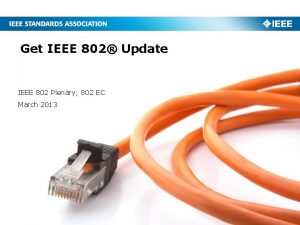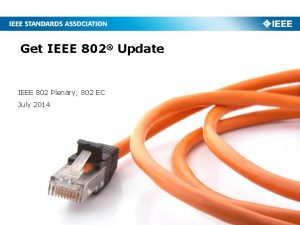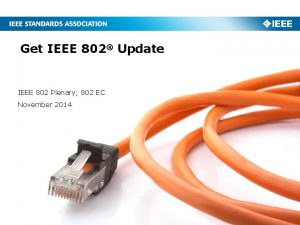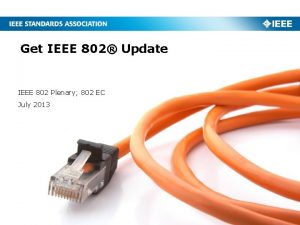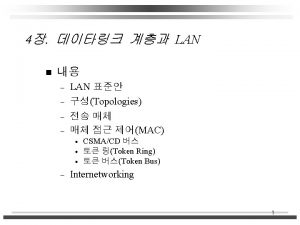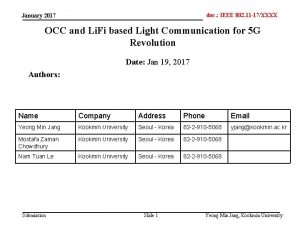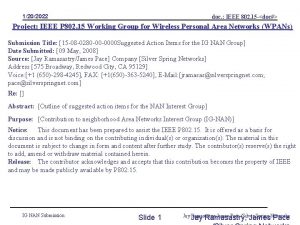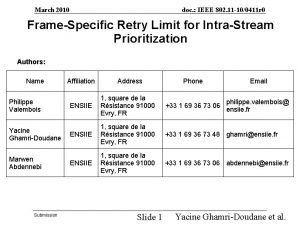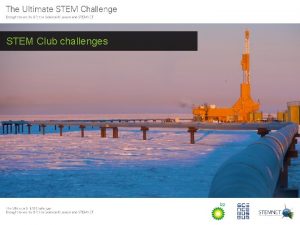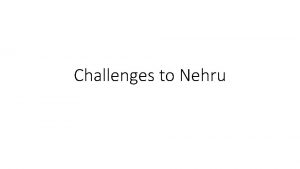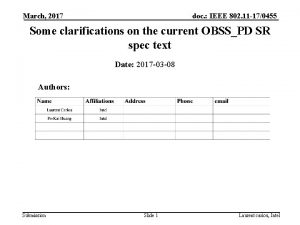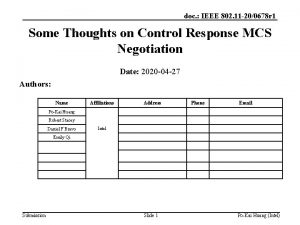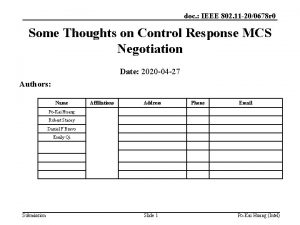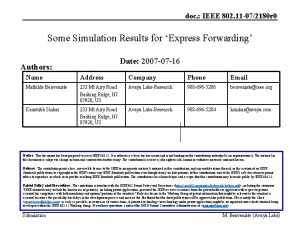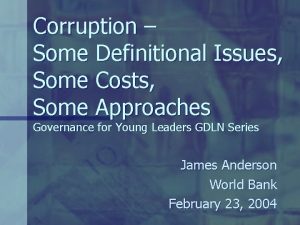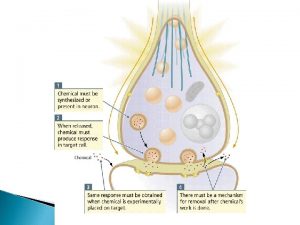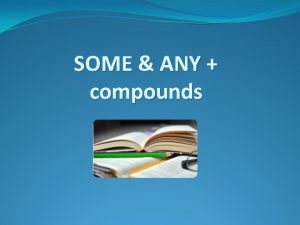doc IEEE 802 15 doc Some Challenges for

























- Slides: 25

doc. : IEEE 802. 15 -<doc#> Some Challenges for Visible Light Communications Dominic O’Brien Lubin Zeng Hoa Le Minh Grahame Faulkner Department of Engineering Science, University of Oxford Submission

doc. : IEEE 802. 15 -<doc#> Introduction • Typical VLC link characteristics • Challenges – Technical • Bandwidth limitations • Providing an uplink – Regulatory • Compatibility with Lighting Control systems • Illumination systems • Conclusions Submission

doc. : IEEE 802. 15 -<doc#> Typical link characteristics • Source • Channel • Receiver Submission

doc. : IEEE 802. 15 -<doc#> LED Modulation • Opto-electronic response SPICE Model Rs = 0. 9727 L = 33. 342 n. H Cs = 2. 8 n. F Cd = 2. 567 n. F tt = 1. 09 ns Luxeon LED Measured LED small-signal bandwidth Submission 3

doc. : IEEE 802. 15 -<doc#> Improvement of LED Response • Using blue-response only (blue filtering) ~130 ns Blue filtering Measured optical spectrum • • Measured impulse response Issue: Only 10% of signal power is recovered Reducing SNR, link distance LEDs with more blue energy [1] could be used to gain more filtered power, however the balance of white colour is shifted [1] Grubor, J. , et al. , "Wireless high-speed data transmission with phosphorescent white-light LEDs", Proc. ECOC 07 (PDS 3. 6), pp. 1 -2. ECO [06. 11], 16 -20 Sep. 2007, Berlin, Germany Submission ~25 ns 4

doc. : IEEE 802. 15 -<doc#> VLC Channel Submission 8

doc. : IEEE 802. 15 -<doc#> Room Power Distribution • Assume – 1% modulation of typical illumination power – Typical receiver performance • Conclusions – Very high SNR available • SNRmin = 38. 50 d. B • SNRmax = 49. 41 d. B – Modulation limited by source bandwidth Submission 9

doc. : IEEE 802. 15 -<doc#> Optical Receiver • Receiver consists of – Optical filter • Rejects ‘out-of-band’ ambient illumination noise – Lens system or concentrator • Collects and focuses radiation – Photodetector (or array of detectors) • Converts optical power to photocurrent – Incoherent detection – Preamplifier (or number of preamplifiers) • Determines system noise performance – Post-amplifier and subsequent processing Submission 11

doc. : IEEE 802. 15 -<doc#> Optical Receiver: Constant Radiance Theorem • Optical ‘gain’ of receiver limited by required field of view Ai i Ai i<=Ao o Ai i<=Ao 2 p o Submission Ao 12

doc. : IEEE 802. 15 -<doc#> Receiver Performance: Figure of Merit • Receiver Figure of Merit (FOM) – Fibre systems • Performance determined by sensitivity (given sufficient detector area) • FOV usually not relevant Field of view 2 p Sr Detector Area A Bit rate Rb – Free space systems • Etendue crucial determinant Submission Receiver sensitivity Pmin 13

doc. : IEEE 802. 15 -<doc#> Improving data rate: equalisation • Transmitter equalisation – High bandwidth – Energy efficiency • Blue filtering – Lose low frequency energy from phosphor • Receiver – Simple analogue equalisation – More complex also Submission

doc. : IEEE 802. 15 -<doc#> Typical waveforms for RX equalisation NRZ data Submission Manchester data

doc. : IEEE 802. 15 -<doc#> Bandwidth Improvement: Post Equalisation • Pre- and post-equalization: single LED link Pre-equalisation: experiment Post-equalisation: simulation Submission 17

doc. : IEEE 802. 15 -<doc#> Improving data rate: complex modulation • High SNR channel – Complex modulation attractive • OFDM – 100 Mb/s over 20 MHz channel [1] • PAM – Simulations show LED characteristics not optimal [1] Grubor, J. , et al. , "Wireless high-speed data transmission with phosphorescent white-light LEDs", Proc. ECOC 07 (PDS 3. 6), pp. 1 -2. ECO [06. 11], 16 -20 Sep. 2007, Berlin, Germany Submission

doc. : IEEE 802. 15 -<doc#> Improving data rate: PAM • Simulation uses measured LED impulse response • Simple 1 st order RX equaliser • 4 -PAM • 24 Mb/s (33 Mb/s NRZ) Further work required Submission

doc. : IEEE 802. 15 -<doc#> Improving data rate: MIMO • Parallel ‘alignment free’ data links • Simulations show linear capacity growth • Experimental results for a simple IR system • Simulations of in-room VLC system Submission

doc. : IEEE 802. 15 -<doc#> Simple IR system Experimental system Submission

doc. : IEEE 802. 15 -<doc#> MIMO VLC: Simulation System Submission 24

doc. : IEEE 802. 15 -<doc#> MIMO VLC: Preliminary Results Position of the receiver Submission Aggregate data rate is linearly proportional to the number of channels and channel rate 25

doc. : IEEE 802. 15 -<doc#> Providing an uplink • VLC good at broadcast • Uplink difficult to achieve – Retro-reflectors • Low speed • Low cost – IR uplink • Separate system • Infrastructure complex and expensive Submission

doc. : IEEE 802. 15 -<doc#> Retro-Reflecting Link • • Novel optical communications between reader and tag Low power (tag has no source) Long range (determined by illumination source ) Visibly secure (user can see beam of light) Submission 18

doc. : IEEE 802. 15 -<doc#> Cooperative communications Base station RF transceiver nic RF transceiver 1 VLC receive r Terminal outside hotspot RF transceiver ns tio ca ns tio ica un mm co atio ns i l un tica omm c mu Op com RF RF VLC transmitter VLC receiver Terminal within hotspot O'Brien, D. C. : ‘Cooperation and cognition in optical wireless communications’, in Fitzek, M. K. a. F. (Ed. ): ‘Cognitive Wireless Networks: Concepts, Methodologies and Visions - Inspiring the Age of Enlightenment of Wireless Communications -’ (Springer, 2007) Submission

doc. : IEEE 802. 15 -<doc#> Providing an uplink: Cooperative systems • Combine VLC with RF • Optical downlink only • RF uplink/downlink – – 100 Mb/s downlink/10 Mb/s RF LAN Fuzzy logic decision making Typical traffic asymmetry Significant performance benefits using combination Hou-J, and O'Brien-Dc: ‘Vertical handover-decision-making algorithm using fuzzy logic for the integrated Radio-and-OW system’, IEEE Transactions on Wireless Communications, 2006, 5, (1), pp. 176 -185 Submission

doc. : IEEE 802. 15 -<doc#> Compatibility with lighting • Most modern systems use PWM dimming – Channel does not exist when light is dimmed • Solutions – Use modulation scheme that ‘incorporates’ PWM dimming (PPM-like) – Use sensing to only transmit in active regions – But both reduce overall data rate • Requirement for closer collaboration with lighting industry. Submission

doc. : IEEE 802. 15 -<doc#> Conclusions • VLC offers high SNR low bandwidth channel – Naturally suited to broadcast • Challenges – Data rate – Uplink – Compatibility • If overcome possibility of low cost method to augment wireless capacity Submission
 Bridges from 802.x to 802.y
Bridges from 802.x to 802.y Bridges from 802.x to 802.y
Bridges from 802.x to 802.y Ieee 802 3 compliance
Ieee 802 3 compliance Ieee802.22
Ieee802.22 Arquitetura ieee 802
Arquitetura ieee 802 802 ieee
802 ieee Ieee 802 standard
Ieee 802 standard Ieee 802 bluetooth
Ieee 802 bluetooth 802 ieee
802 ieee Ieee 802
Ieee 802 Ieee 802 family
Ieee 802 family Chapter 2 population and health key issue 3
Chapter 2 population and health key issue 3 Sometimes you win some
Sometimes you win some Some say the world will end in fire some say in ice
Some say the world will end in fire some say in ice They say sometimes you win some
They say sometimes you win some Some may trust in horses
Some may trust in horses What are some contact forces and some noncontact forces
What are some contact forces and some noncontact forces Nouns cake
Nouns cake Some say the world will end in fire some say in ice
Some say the world will end in fire some say in ice Shivaismen
Shivaismen Centrum för kunskap och säkerhet
Centrum för kunskap och säkerhet Verktyg för automatisering av utbetalningar
Verktyg för automatisering av utbetalningar Kolposkopi px
Kolposkopi px Jag har gått inunder stjärnor text
Jag har gått inunder stjärnor text Tack för att ni lyssnade bild
Tack för att ni lyssnade bild Strategi för svensk viltförvaltning
Strategi för svensk viltförvaltning





























